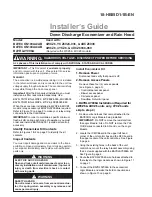
52
For regular condensation drainage, the drainpipe must be tilted downwards
by 2%, with no bottlenecks. There should also be a siphon, with access for
inspection, at least 50 mm down in order to prevent bad smells entering the
environment.
The water can be drained at a maximum of 200 mm above the unit, as long
as the upwards stretch of pipe is vertical and positioned in correspondence
to the drain flange. To drain the water at a height above the permitted 200
mm, install an auxiliary condensation drain pump with collection tray and
level regulator. We recommend models with a safety float to stop the water
flow in the cause of pump malfunction.
The pipes must be covered with anti-condensation material, such as
polyurethane, propylene, neoprene or other expanded materials of 5-10
mm thick. In the case of several units installed in one room, the
condensation collection pipe must be installed as illustrated in the figure.
II. 2.5.3 Creating the water siphon
The condensation drainage system must include a suitable siphon to
prevent outdoors from infiltrating the room. Instructions on how to create a
water siphon are given below.
Always include a cap at the bottom of the siphon for cleaning purposes, or
ensure that it can be quickly disassembled.
50 m
m
100 m
m
II. 2.5.2 Creating the water drain
IMPORTANT!
Position the drainpipe so that it does not place any mechanical stress on the unit drain connection.
II. 2.5.4 Checks
Once installation has been completed, you will need to:
• Bleed the air out of the circuit.
• Make sure that there are no water leaks.
• Cover the valve (if present) and connection pipes carefully with anti-condensation material of 10 mm thick or install
the auxiliary trays.
• Pour water into the condensation collection trays and make sure that the liquid is drained properly, following its
course until it leaves the condensation drain. If this does not occur, check the angle and look for any blockages.
II. 2.5.5 Assembly of the motorized electro thermal valve
The unit control circuit makes it possible to open the motorized valves (see wiring diagrams). When the thermostat
calls cold or hot, terminal 1 and terminal 2 are powered at 230V. The control circuit undertakes to run the
condensation drain pump continuously when the thermostat, by calling cold, keeps the chilled water regulation valve
open towards the coil. In the event of an anomalous rise in the condensation water level in the collection tray (due, for
example, to a defective drain, faulty fan, etc.), this causes the float K3 contact to open and the control circuit
undertakes to operate the condensation drain pump and, at the same time, to close the regulation valve, blocking the
chilled water flow to the coil and thus preventing further condensation from forming.
ATTENTION!
The valve is not just needed to control the ambient temperature, but also to block the chilled water flow to
the coil in the case of an anomalous rise in the condensation water level in the tray.
50
2%
Summary of Contents for CVCX Series
Page 1: ...USER S INSTALLER S MANUAL CVCX Hydronic Cassettes CVCX...
Page 2: ...2...
Page 31: ...2...









































